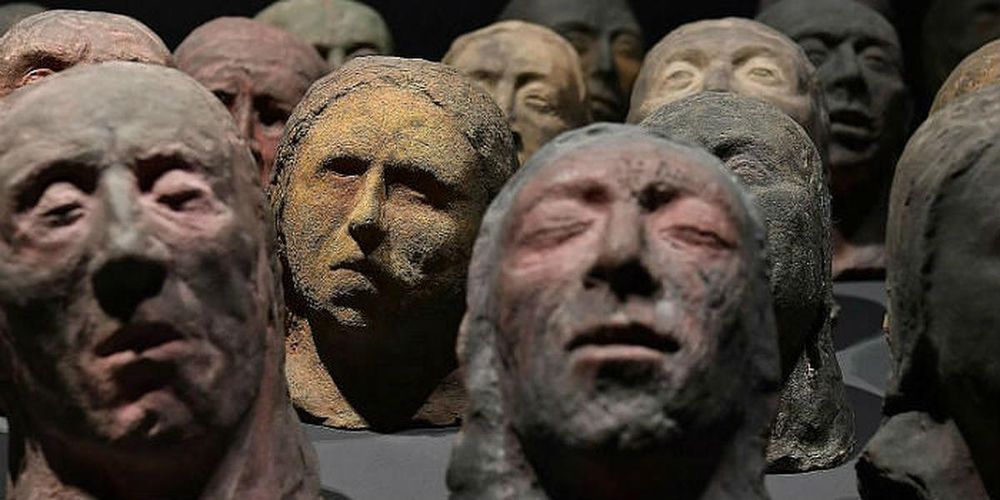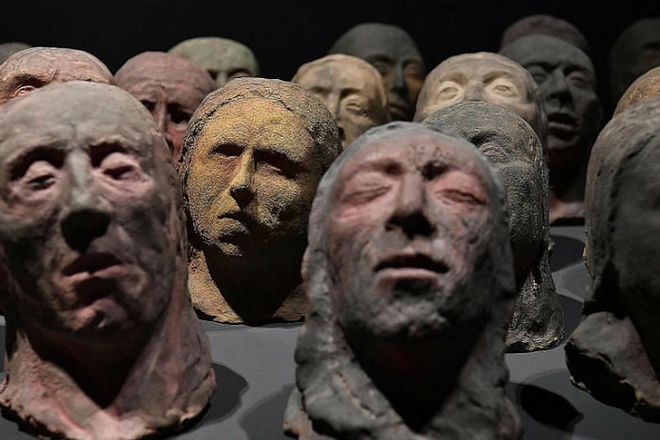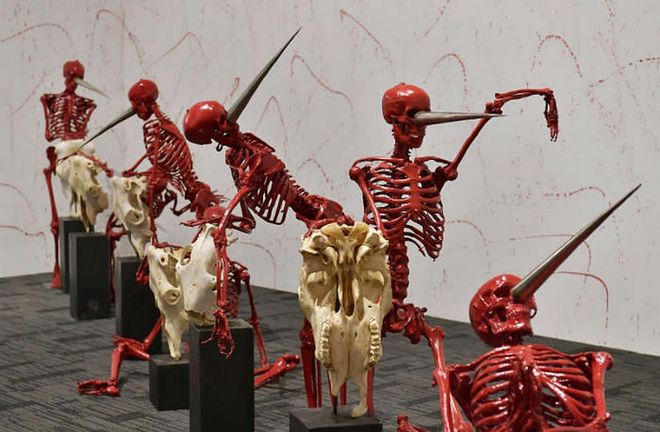"Disturbing Narratives" Artists Give Us A Deeper Look At Their Parkview Museum Exhibits
Paolo Grassino, Bernardi Roig, and Fabien Verschaere share their inspiration and thoughts on the human condition


"The Ghost Of History, 59 Grains Of Clay" (2016) by Italian artist Andrea FogliPhoto: Courtesy
THE GHOST OF HISTORY, 59 GRAINS OF CLAY (2016) by Andrea Fogli
The massive space is silent.
Only the sounds of an eerie, dissonant violin and piano duo emanate from Russian artist Olga Tobreluts’ photography and video installation, filling the room with an air of discomfort.

"A Prisoner In The Caucasus" (2009) by Russian artist Olga TobrelutsPhoto: Courtesy
A PRISONER IN THE CAUCASUS (2009) by Olga Tobreluts
Disturbing Narratives, the third of a thematic series at the Parkview Museum, is a provocative exhibition of both thought and senses.
Featuring over 30 artists from around the world who work with entirely different visual languages and media, this Lóránd Hegyi curated exhibition explores the complexity of irritating and disturbing experiences.
There are no anecdotes or semblance of normality. Instead, there are life-sized red skeletons staged against a “blood” splattered backdrop. A dark turn leads to an array of disembodied terracotta heads. There are massive wall paintings, a collection of screens playing from the ground, and a myriad of unique installations—all designed to incite emotions of fear, uncertainty, ambivalence, and bewilderment, hidden behind the surface and the conventional perception of our daily lives.

"Society of Enemies and Friends" (2019) by German artist Gloria FriedmannPhoto: Ng Sor Luan
SOCIETY OF ENEMIES AND FRIENDS (2019) by Gloria Friedmann
We talked to three Disturbing Narratives artists, Fabien Verchaere (France), Bernardi Roig (Spain), and Paolo Grassino (Italy), to give us an invaluable insight into their work currently exhibited at the Parkview Museum.
FABIEN VERSCHAERE
What inspired you to create your artwork currently displayed at the Parkview Museum?
I wanted to create a real relation between the wall and the visitors. I mean the wall is the symbol of a fake landscape, like a representation of what I have in my brain. Day after day, I record all the images I’ve been exposed to and later I mix everything to create my own mythology. My work is a proposition of different pictures; the visitor must come up with his own story. My inspiration comes from Asian temples’ art, and all the fairy tales of the world.
What is it about your medium of choice that helps you convey your message?
My medium is very simple; painting is like dancing with the music of the wind. I mean it's like writing, just the movement of my brush is important. I love that there is nothing between me and the creative process. It's a way to realize myself without using a big factory or modern technology.
What, to you, is the most intriguing aspect of the human condition (we understand this is a recurring theme in your work), and why?
I strongly believe in the human kind. I'm interested by the symbol of the human, and its place in the earth. Men and women need to believe in something. What my work is about is how people use the subject of my paintings and organise the story of life. Faith is very human.
What do you think are humans’ biggest fears?
I think the main problem of human kind is to be too scared about everything, life is short and it's important to realize your dreams. Humans are scared about time, not enough time and that's the problem of humanity.
What do you hope visitors take away from your exhibited work and the Disturbing Narratives experience?
I'm expecting visitors to just feel, whether positive or negative feelings, with my work but they cant be indifferent to it as it's very powerful like fireworks. As mentioned previously, I would like visitors to create their own story with the subject I proposed. My wall is like a big party where everyone could meet new friends.
Related article: Cool Art Galleries In Singapore To Spend Your Weekend At
BERNARDI ROIG
What inspired you to create your artwork currently displayed at the Parkview Museum?
To make the sculptures I always work with models that are people from my personal environment. The works shown in the Parkview Museum are the continuation of a work started at the beginning of the year 2000. This is a formal and conceptual investigation about the representation of the human figure and its location in space.
An attempt I believe that failed, to embody the idea, to make it visible.
I think that artists make images because we believe that the world still lacks another image and we are going to provide it. This is a titanic and absurd but necessary task, especially assuming this technological present with hyper-saturated images, results with nothing to see.
What is it about your medium of choice that helps you convey your message?
I use different types of media, drawing, sculptures, videos, photography, texts. etc... Material and support come and go depending on the poetic needs of the ideas. These ideas do not come about in function of how they will be rendered in a given format or support. They are born because they can no longer stand being crushed inside a head and their first contact with the outer world is usually through a pencil. The drawing is the beginning of everything because it is the hand that makes the connection with the difficulty of the thought. The line is always the embryo of the artwork. Whether it is ultimately a sculpture, a drawing or a pile of objects chained together it is merely a question to be resolved afterwards.
What, to you, is the most intriguing aspect of the human condition (we understand this is a recurring theme in your work), and why?
We are lonely beings locked in an asphyxiating autism. We are, if we are something, an amalgam of miscommunication, loneliness and death. We are Individuals desperately looking for "others" to give them an indication of their own identity. That identity can only be transversal, hybrid and mixed. My work tries to collide the loneliness of the individual with the emptiness it occupies. From this friction new fictions can be born.
What do you think are humans’ biggest fears?
Without a doubt, the fear of death. I believe that all our actions are a permanent challenge to death and our best weapon to defile and delay it, is the creative act. Art is desire and desire is arrogant, therefore it discredits death and frightens it.
What do you hope visitors take away from your exhibited work and the Disturbing Narratives experience?
The spectator is a gargantuan and multi-brain monster. He is an incestuous copulator, he fertilizes the image he looks at because it is of his lineage, what is not part of his species does not interest him. That is why this exhibition of Lóránd Hegyi is so important in the Parkview Museum, because the one that enters the museum will never be the same one that leaves the museum. It is an experience that transforms our gaze. Art works like a mirror that shows a burning face, our burning face. It is that coagulated moment that collapses our securities, where our look is returned to us, cracked and fragmented, to take us to places we would never have imagined.
Related article: The Louis Vuitton Capucines Bag Gets Remixed By 6 Contemporary Artists
PAOLO GRASSINO
What inspired you to create your artwork currently displayed at the Parkview Museum?
The work titled Riots (two towers) was firstly created in 2016. Throughout time, this artwork has been enlarged and modified until the current version which is now displayed at The Parkview Museum Singapore. The works originates from a reflection on the apathy that characterized many layers of society, including the cultural elite I belong to. This sort of indolence spreads both in the West and in the East.
Both towers of the work, representing respectively the West and the East, face each other and embody this modern pathology of apathy and indifference. The leadership exerts a political power using the energy of those who are subject to its authority. The posture of the dogs’ bodies reflects an attitude of aggressiveness, defence and control of a territory made of chairs: only the skeleton of the chairs is left. Deprived of their original function, they are arranged in an architectural structure of discarded elements that tend to expand vertically. These dogs, with no eyes and mouth, no longer obey to their owner: they live in a static condition and they embody the symbols of the most primitive sides of human soul. They represent an archetype of mankind in contemporary society.
What is it about your medium of choice that helps you convey your message?
In my work, I address existential issues that are leitmotivs constantly present regardless of the different cultural context or the different stage in technological advancement. Some of the characteristics of human soul do not change or they change very slowly. In some historical phases, like at the end of the millennium, we had the illusion that mankind would have entered a new epoch and would have undergone substantial changes. Then 9/11 happened and the Iraq war broke; fear, cultural divergences and social tensions became again at the centre of attention of our daily life.
To realize my work, I use those material that seem to me more suitable according to the theme and the subject matter I am working on. I am not necessarily attached to any specific material or object. I don’t think artists should have always the same stylistic technique: I think this could be more appropriate for an artisan rather than an artist. The most important thing is the message that an artist wants to convey rather than the technical medium. I use techniques that belong to the historical researches and experimentation of contemporary art. I combine conceptual experimentation with pictorial practices, figurative, abstract and surrealist elements. My works are also subject to the influence of cinema, photography and music. In my work, I put together what instinctively attracts me the most: the final result is a synthesis of different elements that I elaborate and re- interpret in an original way.
What, to you, is the most intriguing aspect of the human condition (we understand this is a recurring theme in your work), and why?
I have an ambivalent vision about human condition: there are many aspects of human nature that can be improved: maybe this is an issue related to politics and society rather than to art. Sometimes I am afraid of people, especially when they get radicalized about a religious faith or an ideological belief. I am sad when I think about how humans are damaging nature: the detachment from nature undermined the existential harmony. I have resentment when I think of how people who live in a condition of misery and slavery are treated. I suffer for those who are humiliated or forgotten. I feel embarrassed when I think about all the refugees who die in the Mediterranean Sea. Through my art, I explore these apocalyptic issues and their characteristics. However, art is not sociology, philosophy or politics. Art, like poetry, can be associated to a sort of lack: it poses questions to those who are willing to communicate with it.
What do you think are humans’ biggest fears?
Unlike many people believe, I don’t think death is the bigger fear of people in contemporary society. The biggest fear are now apathy and the obsession of losing what we have, mainly in terms of material property. We constantly live connected with each other and we pursue the others’ approval in order to give sense to our existence.
What do you hope visitors take away from your exhibited work and the Disturbing Narratives experience?
My last experience collaborating with The Parkview Museum Singapore has been a confirmation of the fact that the vision and the dream of George Wong (The late Hong Kong Parkview Group Chairman and Founder of The Parkview Museum) linger throughout the time, even after his passing away. This dream conveys to people the idea of beauty and encourages people to think. The Parkview Museum and its exhibition program address a large public, including those who are not knowledgeable about contemporary art. This openness and the willingness to share the passion of art is a gift, similar to “The Gift of the Artist”. So, I hope that the viewers of Disturbing Narratives will take away with them a small piece of this dream.
Check out the DISTURBING NARRATIVES exhibition at the Parkview Museum (Level 3 Parkview Square) from now until 8 February 2020.
Related article: Celebrate The Beauty Of Art In Fashion With Our July 2019 Issue